Submarine with dynamite gun USS Holland (USA)
The project of a promising submarine with torpedo and artillery weapons was developed by engineer John Philip Holland, for a long time engaged in the subject of submarine vessels. By the mid-nineties of the XIX century, he proposed another version of a promising submarine, which could be offered to the customer in the face of the US Navy. The fleet showed interest in the new development and approved the construction of the boat. Soon J.F. Holland, together with other specialists in the shipbuilding industry, began construction of a submarine.
The laying of the new submarine took place in November 1896 of the year. Construction was proposed to be carried out at the Crescent Shipyard in Elizabeth (pc. New Jersey), owned by retired Navy officer Lewis Nixon. Specialists from the Holland Torpedo Boat Company, headed by J.F. Holland Together, representatives of the two organizations for several months were able to build a submarine with the required characteristics. During the laying of the new submarine received the name Holland VI - by the name of the author and the ordinal number of its development.
The Holland VI project was based on previous designs by J.F. Hollanda By the mid-nineties, the engineer managed to build and test several experienced submarines, which differed from each other in various features. The project behind the number "VI" meant the construction of a full-fledged submarine capable of moving both on the surface and at a certain depth, as well as carrying various weapons to attack the enemy, located at sea and on the coast.
The project proposed the construction of a torpedo-shaped streamlined durable hull with an elongated streamlined lightweight superstructure on its upper part. The hull was to consist of internal power set and outer skin. Inside the robust hull all the main components and assemblies were to be placed, while the superstructure was intended to improve the flow and to install some systems, first of all weapons. The main features of the perspective boat were identified at the early stages of the project development and did not change in the future. At the same time, according to the test results, the need was identified for some modifications that were made before the boat was handed over to the customer.
The main element of the submarine "Holland VI" was a solid torpedo-shaped hull with rounded outer contours, an ogival bow and a conical stern. On top of it mounted setting with a narrow fore and aft, extending in the middle of the boat. On the superstructure there was a protruding cylindrical tower-tower with a sunroof. In the upper part of the cabin there was a set of viewing devices of the simplest design. On the aft end of the hull stabilizers of a relatively simple design were provided, inside which there was a propeller. Behind the screw, a system of two X-shaped rudders was installed to control the course and depth.
The length of the Holland VI submarine was 16,4 m, the maximum width was 3,15 m, and the draft was 2,6 m. The surface displacement was 65 t and the full displacement was 75 t. The hull strength allowed diving to a depth of 75 feet (23 m).
Inside the submarine hull there was one common compartment that contained all the necessary components and assemblies, as well as crew jobs. In the lower part of the hull, directly above the bottom, were placed several tanks and cisterns for various purposes. There is also a battery. In the fore and aft parts there were differential tanks needed to hold the boat “on an even keel”. Behind the bow of the tank was placed fuel tank. All other space above the bottom of the hull was given for the installation of the main ballast tank. Above the last, near the center of gravity of the whole structure, was a battery pack.
Next to the rear part of the battery compartment was an electric motor with a compressor. The task of these devices was to create pressure in gas cylinders. The cylinders themselves were placed at the sides of the hull, above the tank and batteries. The cylinders and compressor were designed to purge the ballast tanks. In addition, it was proposed to use them for firing artillery weapons.
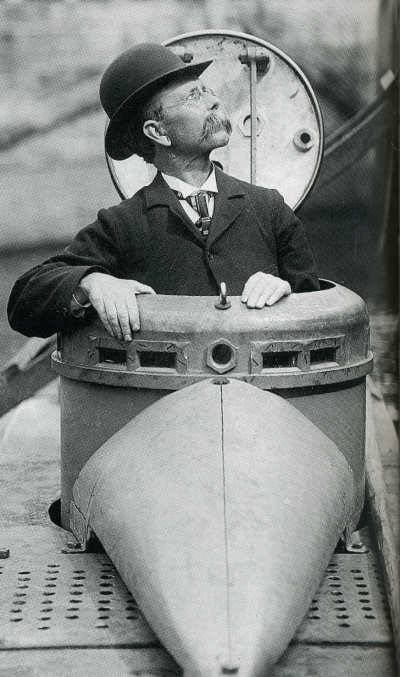
John Philip Holland in the deckhouse of the USS Holland. Photo of Wikimedia Commons
Above the battery pack, the main power plant was located. Its basis was the single-cylinder petrol engine of the N. Otto system, with an HP 45 power. The task of this engine was to provide mobility in the surface position with simultaneous recharge of batteries. Behind the gasoline engine was installed electric motor power 50 hp manufactured by Electro Dynamic. The electric motor, receiving energy from the battery, was responsible for the underwater movement. An interesting feature of the power plant was the use of a common propeller shaft connected to the engine of the desired type. A generator was installed on the shaft to recharge the batteries.
The power plant used allowed the submarine to reach speeds up to 6 nodes in the surface position. In the submerged state, the maximum speed was less on the 0,5 node. At the maximum possible speed of movement, the navigation range in the surface position was 200 nautical miles, under water - 30 miles. For its time, these characteristics were quite high and allowed to fully solve the existing problems.
According to the original draft, the Holland VI submarine was to carry torpedo and artillery weapons. In the bow of the boat was located one torpedo tube, located with a slight inclination forward. It was proposed to use it for shooting “self-propelled mines” of the Whitehead caliber 18 inches (460 mm). Immediately above the apparatus was placed the stacking for ammunition. In addition, the breech of the dynamite gun was above the rear end of the torpedo tube.
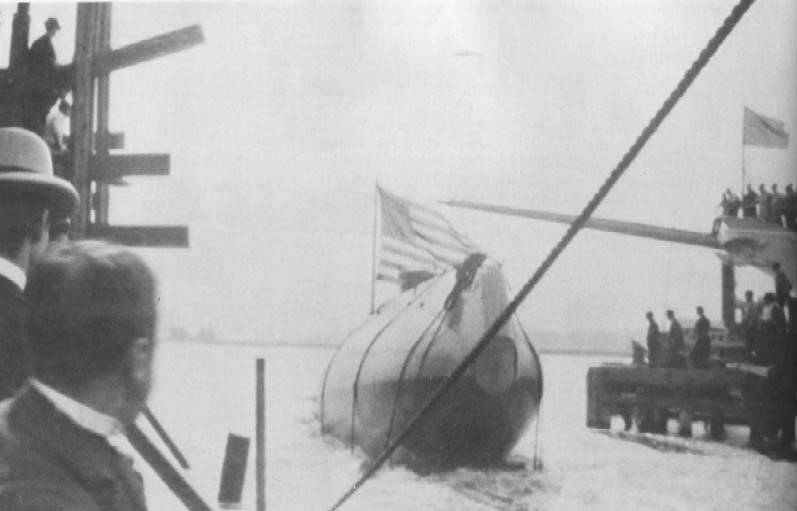
Launching. Photo Navsource.org
The nasal dynamite implement was an 8,4 inch caliber system (213 mm), based on the developments of Lieutenant Edmund Zalinsky. The smooth barrel had to be rigidly mounted in the submarine hull with a fixed angle of elevation. At the same time, the breech breech turned out to be inside the body, and the muzzle part went beyond its limits and continued to the nose of the superstructure. To protect the implement from water, a hinged cover was provided on the superstructure, controlled from the inside. Ammunition was to be thrown using compressed air. When the combat valve was opened, the compressed air from the cylinders had to flow into the barrel bore and throw the projectile.
For a promising submarine, an updated version of the dynamite projectile was developed, called the "air torpedo". This product was supposed to have a streamlined torpedo-shaped body, inside which was placed a charge of explosive jelly. To stabilize in flight, the projectile had several planes in the tail section.
The original project involved the use of another barreled weapon. In the stern of the boat at the angle to the horizontal was to be attached second weapon. According to some sources, the use of a second dynamite gun was suggested, while others suggest using a small-caliber torpedo tube for the so-called. dynamite torpedoes. On the existing drawing describing the design of the submarine, in the aft part of the hull is a system with a "dynamite torpedo".
Inside the robust hull racks were provided for the transport of ammunition. It was possible to take on board three Whitehead 480-mm torpedoes, one of which was transported directly in the torpedo tube, and two more were being laid above it. The crew also had several dynamite shells for cannons or cannons.
The Holland VI submarine needed a crew of six. Their task was to monitor the work of various units, control all on-board systems, navigation, search for targets and shooting from existing weapons. It was suggested to get inside the hull through the hatch on the wheelhouse. The periscope was absent, because of which for the search for targets it was necessary to use the cutting glazing. It was used both for tracking the situation and searching for targets, and for aiming at shooting.
The existing weapons complex allowed attacking surface and coastal targets with a weapon of sufficiently high power, the most appropriate for the type of object being attacked. So, the ships should be fired using torpedoes, and a dynamite gun could be used against coastal targets. How effective such weapons were is unknown. Information about the tests of weapons and their results are not preserved.
The first American combat submarine of the modern appearance was launched on the 17 in May 1897 of the year. After the construction was completed, the boat was sent to the tests, which took several years. For a long time, the specialists of the developer company and the shipyard that built the submarine, carried out checks of various systems, studied the ship’s behavior in different modes, and also corrected the identified deficiencies. According to the results of those or other stages of testing, it was possible to identify and eliminate various defects, as well as to make some major changes to the design.
At a certain stage of testing, it was found that the existing exhaust device of a gasoline engine is not very high and therefore needs to be replaced. Soon, a new device of similar purpose was developed, but for its installation it was necessary to change the design of the robust hull and superstructure. Moreover, it became necessary to abandon some of the existing units. The pipes of the new exhaust device were laid in the rear part of the superstructure, which made it necessary to remove the second gun from there. After such a revision, the Holland VI’s weapons complex was reduced to one torpedo tube and one dynamite gun located in the nose. The stern weapon was removed.
After finalizing and improving the design, a promising submarine was offered to the customer in the person of the United States Navy. Specialists fleet studied the proposed model of equipment and recommended it for adoption. On April 11, 1900, the submarine Holland VI was bought by the military with the aim of subsequent introduction into the combat fleet. In accordance with the agreement between the military department and the company Holland Torpedo Boat Company, 150 thousand dollars were paid for the submarine.
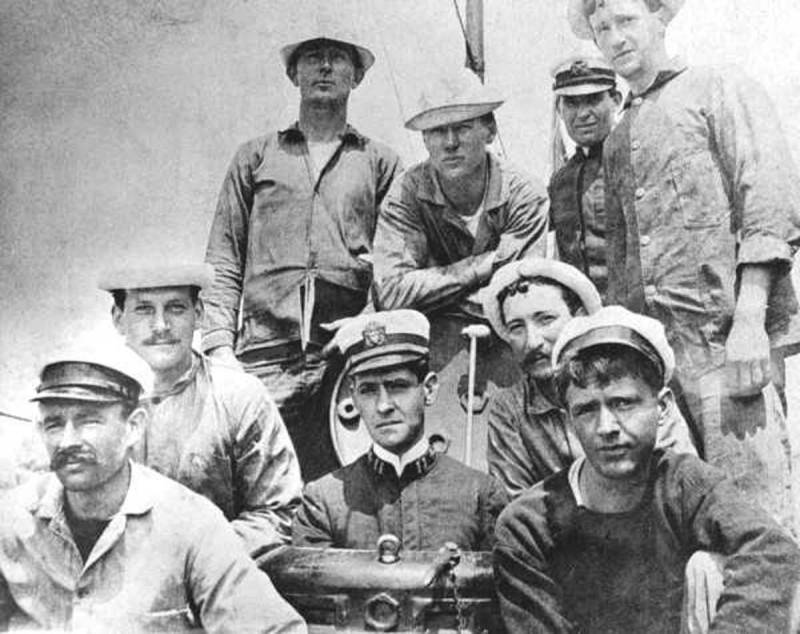
The crew of the submarine. In the wheelhouse - the first commander Harry Handley Caldwell. Photo Insideannapolis.com
After several months of additional checks, preparation of the base and training of the crew, the submarine was accepted into the fleet. The service of the first modern US submarine officially began on October 12 of the year 1900. The submarine received the designation USS Holland (SS-1). To serve the boat was based on Newport (pc. Rhode Island), the commander was appointed Lieutenant Harry Handley Caldwell. He became the first in stories US commander of a submarine.
The submarine USS Holland was accepted into the fleet in mid-autumn, because of which it soon had to be transferred to a new base. In order to avoid possible damage by ice after the expected cooling of 16 in October, the boat was sent to a new duty station. With the help of the tugboat Leyden, she was transferred to Annapolis base (Maryland). There, the submarine became a training tool used in the training of cadets of the Naval Academy. The main task was to train crews for new submarines, which were planned to be built in the very near future.
8 January 1901, the submarine "Holland" entered the first autonomous voyage. The end point of the route was the city of Norfolk, where she arrived on January 10. The hike lasted just a couple of days, but during this short time the crew gained valuable independent work experience away from the coast in conditions as close as possible to actual combat exploitation. In addition, the most important data necessary for the further development of the submarine fleet were collected. The experience gained was realized in the very near future: in the 1900-1901 years, several Plunger-type submarines were laid at several American shipyards.
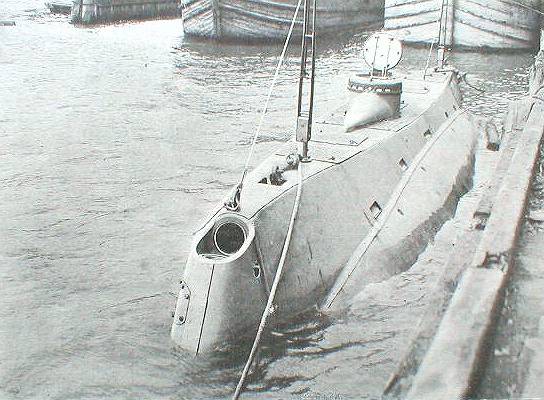
The submarine at the pier. The cover of the nasal dynamite tool is missing. Photo of Wikimedia Commons
After the first "autonomous" submarine returned to Annapolis. There she continued her military service, occasionally going to other ports to assist in the training of cadets. Annapolis Port remained the base for USS Holland (SS-1) until July 17 1905. By this time, the naval forces received new submarines such as Plunger, which is why Holland was transferred to the category of training ships. In 1905, the submarine was transferred to Norfolk, where she continued to work as a means of crew training. This role was the first American submarine played until the end of the decade.
On November 21, 1910, the submarine USS Holland (SS-1) was removed from the naval forces. Over the next several years, a unique sample of military equipment stood idle, after which it was sold for scrap. On June 18, 1913, the War Department entered into a sales agreement with Henry A. Hitner & Sons. The first combat submarine was sold for just $ 100. In accordance with the contract, the buyer guaranteed the non-use of the purchased sample in its original quality. Otherwise, he would have to pay a $ 5000 fine.
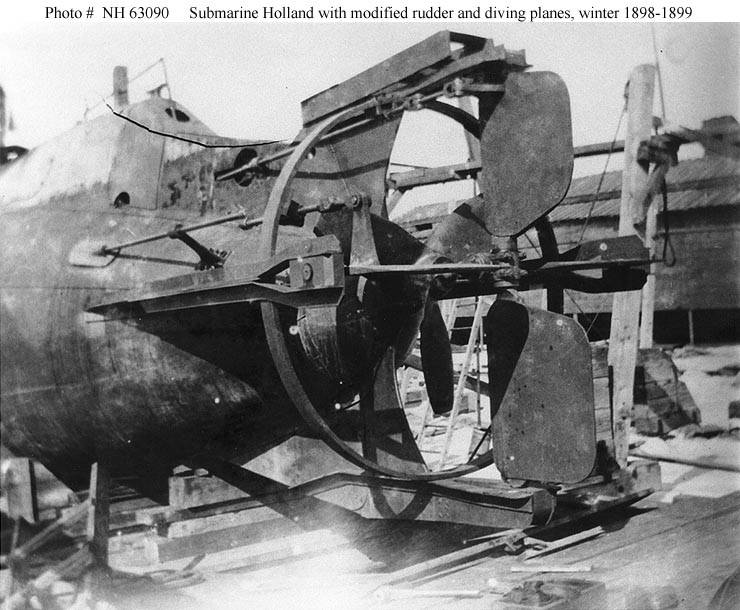
Propeller and steering system. Photo Navsource.org
After the transfer to the new owner, the submarine lost some of the external and internal aggregates, after which it again went to storage. In 1915, it was acquired by a certain Peter J. Gibbons, thanks to which everyone could see a unique sample. At the end of 16, the boat became an exhibit in Philadelphia. In May, the USN Holland 1917 became part of the exposition of the International Exhibition of the Science of Art and Industry in the Bronx, New York. After the exhibition was closed, the submarine was sent to Peterson (New Jersey), where it once again became a monument to itself.
By the beginning of the thirties, the partially disassembled submarine had become unusable and could no longer be used even as an exhibition sample. In 1932, another contract was signed for its transfer to another host. Now the former submarine was sent for recycling. In the same year, at one of the US factories, the first modern naval submarine was dismantled for metal and went to the smelter.
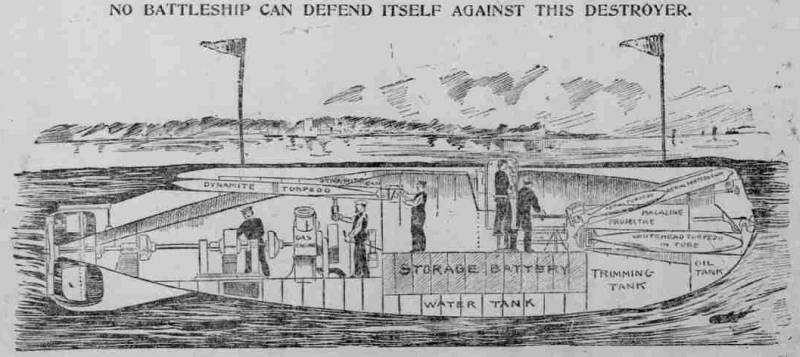
"Not a single warship can defend against this destroyer": drawing from The Salt Lake Herald newspaper, 27 March, March 1898 / Navsource.org
USS Holland (SS-1) was the first submarine of the modern look, designed, built and adopted by the United States fleet. Based on the experience gained during its construction and testing, in the future new submarine projects were developed, brought to serial construction. Thanks to the project of J.F. Holland, the American shipbuilders got the opportunity to test new equipment, as well as to determine the requirements for future developments of this class. In particular, great prospects for torpedo weapons and limited artillery capabilities were confirmed. In this case, however, it was decided to abandon the dynamite guns in favor of powder artillery. At the time of the appearance of the first submarine, such weapons were of some interest, but further progress in the field of artillery systems led to a halt in the development of dynamite guns.
As a result, the USS Holland submarine (SS-1) reserved for itself not only the honorary title of the first representative of its class in the US Navy. She also left the title of the first and last submarine, armed with a dynamite gun. However, the benefits associated with such weapons have not been implemented in practice. Most of the time of its service, "Holland" was actually a training ship, and besides, for ten years she had not had the opportunity to take part in real combat operations. The first American submarine did not show any outstanding qualities - both its own and dynamite artillery - but it contributed to the further development of the promising direction.
On the materials of the sites:
http://ussholland.org/
http://dawlishchronicles.com/
http://navsource.org/
http://insideannapolis.com/
https://laststandonzombieisland.com/
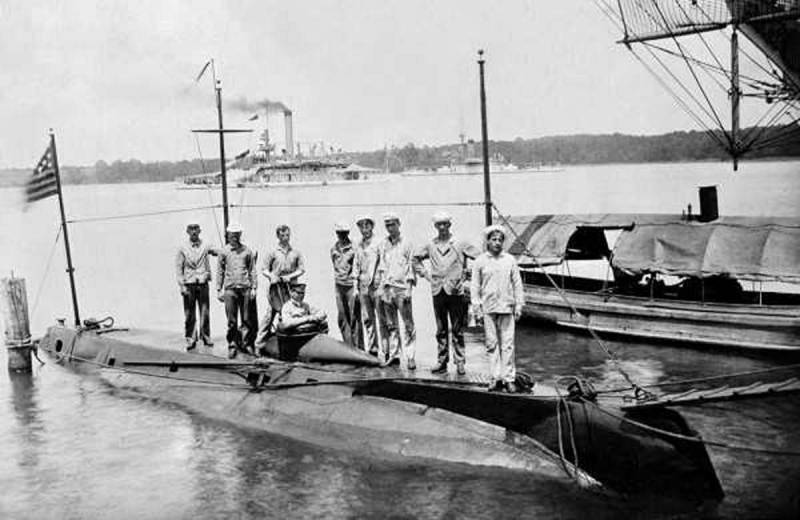
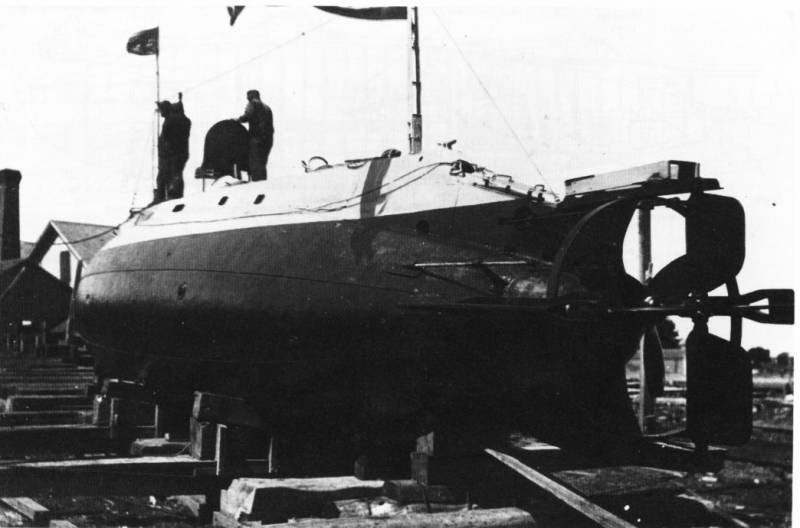
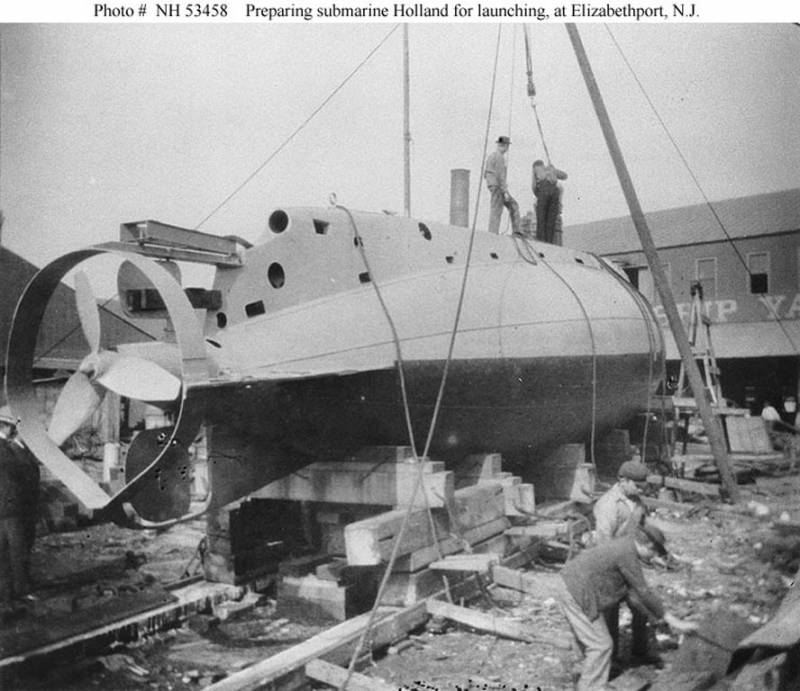

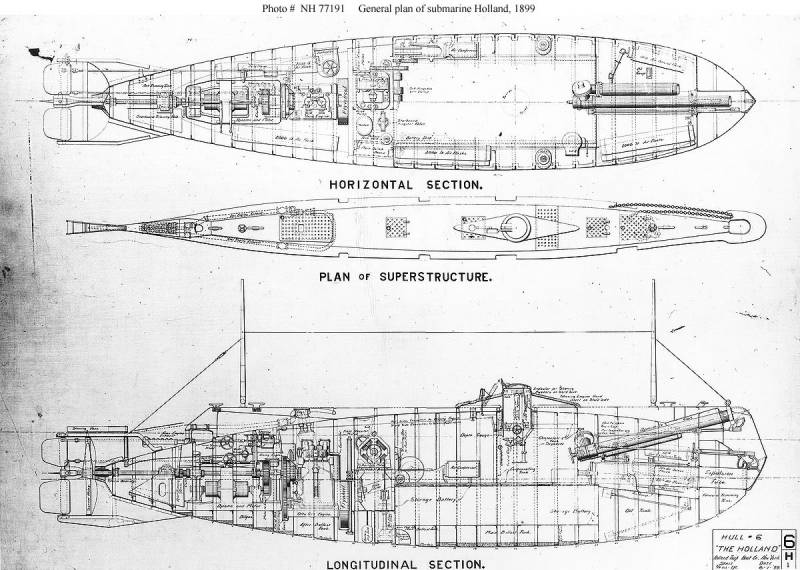
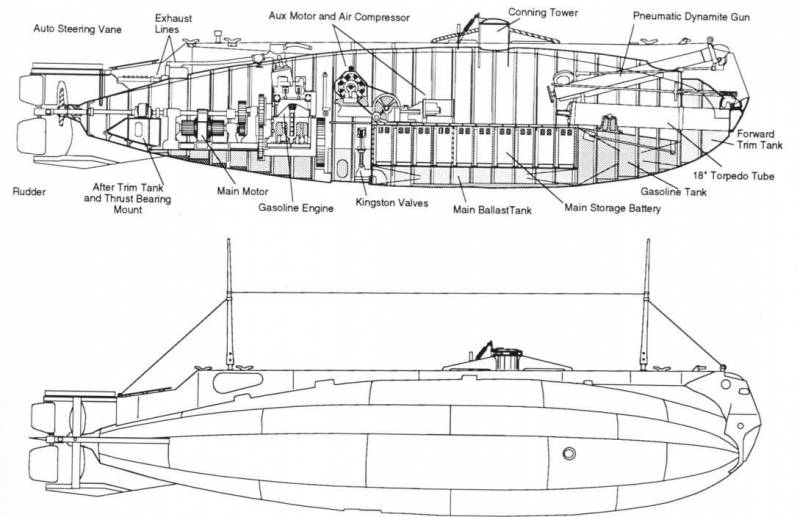
Information